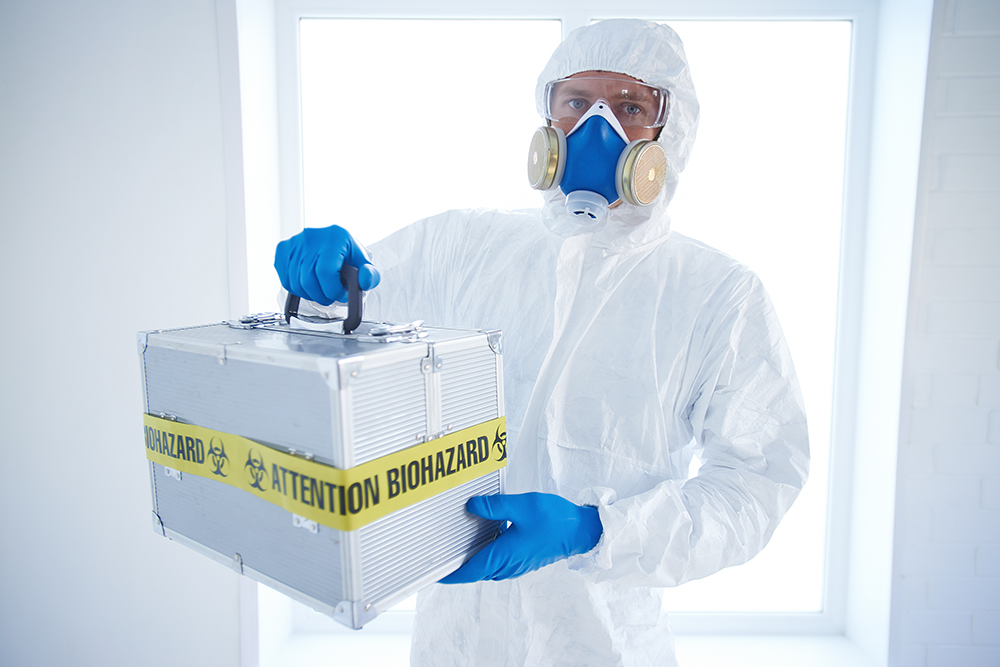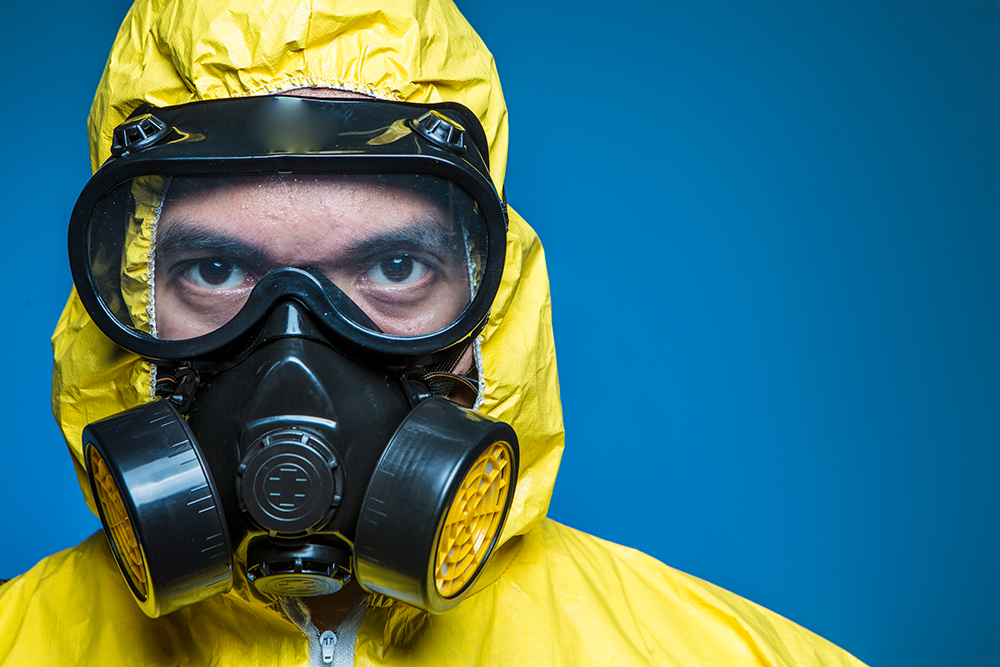Mold Remediation Services: Shielding Your Building from Mold Damage
Mold Remediation Services: Shielding Your Building from Mold Damage
Blog Article
Expert Biohazard Cleaning and Purification for Blood, Bodily Fluids, and Hazardous Materials
The prospective health and wellness dangers associated with exposure to biohazards emphasize the essential need for careful handling and detailed cleanup. As we navigate the elaborate landscape of biohazard clean-up, recognizing the subtleties of regulations, conformity, and the customized tools at play ends up being important in making certain a safe and complete purification procedure.
Wellness Risks of Biohazard Exposure
Direct exposure to biohazards presents substantial health risks that can cause severe consequences for communities and people alike. Biohazards include a large range of organic substances, including blood, bodily fluids, mold, microorganisms, infections, and other potentially infectious materials. When people enter contact with these biohazards, whether through crashes, inappropriate handling, or environmental exposure, they encounter the risk of contracting significant health problems or conditions.
One of the main wellness risks connected with biohazard exposure is the transmission of infectious diseases. Bloodborne virus such as HIV, hepatitis B and C, and numerous bacteria can be existing in biohazardous materials, posing a straight risk to human health and wellness. Breathing in airborne biohazards like mold and mildew spores or entering contact with polluted surface areas can also result in breathing problems, allergies, and other adverse health results.
Additionally, biohazard exposure can have long-term wellness effects, with some illness materializing years after the preliminary contact (Blood Cleanup). Therefore, it is critical to focus on appropriate biohazard cleansing and purification to minimize these health and wellness risks and make certain the security of communities and people

Specialized Educating for Biohazard Clean-up
When it pertains to handling biohazard clean-up effectively and securely, specialized training plays a fundamental duty in making sure proper decontamination procedures are followed. Biohazard clean-up calls for particular knowledge and abilities to successfully minimize dangers connected with bloodborne virus, bodily liquids, and hazardous materials. Specialists trained in biohazard clean-up undergo strenuous direction on exactly how to securely deal with, eliminate, and take care of biohazardous products to avoid contamination and direct exposure.
Specialized training for biohazard cleaning covers a variety of important topics, consisting of correct individual safety tools (PPE) use, bloodborne virus understanding, decontamination techniques, and hazardous waste disposal protocols. Individuals educated in biohazard cleaning are equipped with the necessary proficiency to analyze contamination levels, recognize prospective risks, and implement ideal clean-up procedures in conformity with regulative requirements.
Continual training and education and learning are critical in the area of biohazard cleanup to stay upgraded on the current decontamination modern technologies, safety and security procedures, and policies. By buying specialized training, biohazard cleaning experts can efficiently react to emergency situation cleanup situations and guard both public health and wellness and the environment.
Relevance of Correct Purification Methods
Utilizing correct decontamination techniques is crucial in biohazard cleanup to properly reduce and remove unsafe products wellness threats. Reliable purification not just makes sure the removal of visible traces of blood, physical fluids, and various other biohazards yet likewise targets click to read more undetectable microorganisms that may present severe wellness risks otherwise properly gotten rid of. By adhering to rigid decontamination protocols, educated specialists can substantially minimize the risk of exposure to harmful bacteria, viruses, and microorganisms that might lead to diseases or infections.
Appropriate purification strategies involve using specific equipment and disinfectants that are particularly created to counteract biohazards effectively. Complete cleaning and disinfection of contaminated areas are vital to stop the spread of virus and ensure a secure environment for passengers. Furthermore, the proper disposal of biohazardous waste adhering to decontamination treatments is essential in stopping contamination of various other surface areas or individuals.

Tools and Devices for Safe Clean-up
The appropriate equipment and devices play a critical duty in making certain the effective and risk-free clean-up of biohazardous products. When managing blood, physical liquids, or harmful materials, biohazard cleansing experts count on specialized equipment to minimize direct exposure threats and completely decontaminate the affected area. Individual safety devices (PPE) such as handwear covers, goggles, coveralls, and masks are important to safeguard versus straight call with potentially infectious products. Additionally, biohazard cleansing packages including disinfectants, absorbent materials, and biohazard bags are utilized to securely consist of and get rid of of contaminated items. Blood Cleanup.
Advanced cleansing devices like hospital-grade anti-bacterials, HEPA-filtered vacuums, and misting equipments are employed to sterilize surfaces and get rid of biohazards successfully. Specialized devices such as sharps containers and biohazard waste disposal bins are utilized to securely manage sharp items and biohazardous waste products. By using the ideal devices and devices, biohazard cleaning experts can guarantee a comprehensive cleanup procedure that prioritizes safety and decreases health risks for both employees and occupants of the damaged space.
Rules and Compliance in Biohazard Cleaning
Appropriate adherence to regulations and compliance standards is vital in biohazard cleaning to check here make sure the security of both personnel and the environment. Government firms such as OSHA (Occupational Security and Health And Wellness Administration) and the EPA (Environmental Protection Company) have actually established certain guidelines for biohazard clean-up treatments to minimize health risks and environmental contamination. These guidelines cover a series of elements consisting of the handling, transportation, and disposal of biohazardous materials, along with the required training and protective tools required for workers associated with the clean-up procedure.
Biohazard cleaning business must remain updated with these policies to assure that their operations meet the called for security standards. Failing to abide by these regulations can cause extreme consequences, consisting of fines, lawful activity, and threatening the health and wellness of individuals and the atmosphere. By complying with rigorous policies and conformity actions, biohazard cleaning companies can effectively alleviate dangers and make certain a detailed and safe clean-up process for all parties involved.
Conclusion
Finally, biohazard cleansing and decontamination call for specific training, correct strategies, and adherence to guidelines. Exposure to blood, bodily fluids, and dangerous materials postures substantial wellness dangers, making it crucial to make use of the best tools and devices for secure cleaning. By following rigorous methods and guidelines, professionals can effectively reduce the threats related to biohazard exposure and make certain the safety of both themselves and others.
As we browse the intricate landscape of biohazard clean-up, understanding the subtleties of laws, compliance, and the specific devices at play becomes important in ensuring a risk-free and thorough purification process. (Blood Cleanup)
When it comes to taking care of biohazard cleaning effectively and securely, specialized training plays a fundamental function in guaranteeing appropriate decontamination procedures are followed.Utilizing appropriate decontamination methods is critical in biohazard cleaning to properly get rid of harmful products and reduce health dangers. Furthermore, biohazard cleaning packages consisting of anti-bacterials, absorptive products, and biohazard bags are used to securely contain and get rid of of polluted products.
Government firms such biohazard cleanup certification as OSHA (Occupational Security and Health Management) and the EPA (Environmental Defense Agency) have actually established specific guidelines for biohazard cleaning treatments to lessen wellness threats and environmental contamination.
Report this page